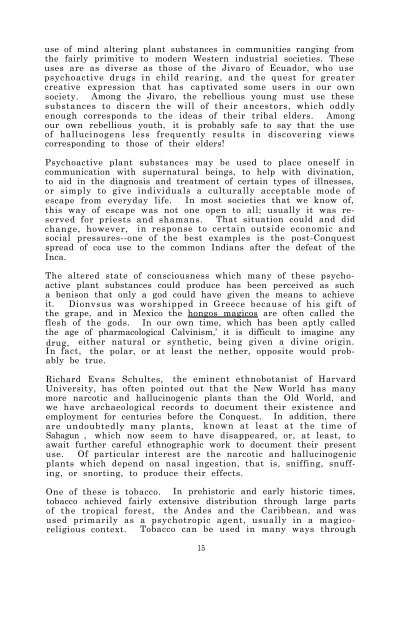Review of Inhalants - ARCHIVES - National Institute on Drug Abuse
Review of Inhalants - ARCHIVES - National Institute on Drug Abuse
Review of Inhalants - ARCHIVES - National Institute on Drug Abuse
Create successful ePaper yourself
Turn your PDF publications into a flip-book with our unique Google optimized e-Paper software.
use <str<strong>on</strong>g>of</str<strong>on</strong>g> mind altering plant substances in communities ranging from<br />
the fairly primitive to modern Western industrial societies. These<br />
uses are as diverse as those <str<strong>on</strong>g>of</str<strong>on</strong>g> the Jivaro <str<strong>on</strong>g>of</str<strong>on</strong>g> Ecuador, who use<br />
psychoactive drugs in child rearing, and the quest for greater<br />
creative expressi<strong>on</strong> that has captivated some users in our own<br />
society. Am<strong>on</strong>g the Jivaro, the rebellious young must use these<br />
substances to discern the will <str<strong>on</strong>g>of</str<strong>on</strong>g> their ancestors, which oddly<br />
enough corresp<strong>on</strong>ds to the ideas <str<strong>on</strong>g>of</str<strong>on</strong>g> their tribal elders. Am<strong>on</strong>g<br />
our own rebellious youth, it is probably safe to say that the use<br />
<str<strong>on</strong>g>of</str<strong>on</strong>g> hallucinogens less frequently results in discovering views<br />
corresp<strong>on</strong>ding to those <str<strong>on</strong>g>of</str<strong>on</strong>g> their elders!<br />
Psychoactive plant substances may be used to place <strong>on</strong>eself in<br />
communicati<strong>on</strong> with supernatural beings, to help with divinati<strong>on</strong>,<br />
to aid in the diagnosis and treatment <str<strong>on</strong>g>of</str<strong>on</strong>g> certain types <str<strong>on</strong>g>of</str<strong>on</strong>g> illnesses,<br />
or simply to give individuals a culturally acceptable mode <str<strong>on</strong>g>of</str<strong>on</strong>g><br />
escape from everyday life. In most societies that we know <str<strong>on</strong>g>of</str<strong>on</strong>g>,<br />
this way <str<strong>on</strong>g>of</str<strong>on</strong>g> escape was not <strong>on</strong>e open to all; usually it was reserved<br />
for priests and shamans. That situati<strong>on</strong> could and did<br />
change, however, in resp<strong>on</strong>se to certain outside ec<strong>on</strong>omic and<br />
social pressures--<strong>on</strong>e <str<strong>on</strong>g>of</str<strong>on</strong>g> the best examples is the post-C<strong>on</strong>quest<br />
spread <str<strong>on</strong>g>of</str<strong>on</strong>g> coca use to the comm<strong>on</strong> Indians after the defeat <str<strong>on</strong>g>of</str<strong>on</strong>g> the<br />
Inca.<br />
The altered state <str<strong>on</strong>g>of</str<strong>on</strong>g> c<strong>on</strong>sciousness which many <str<strong>on</strong>g>of</str<strong>on</strong>g> these psychoactive<br />
plant substances could produce has been perceived as such<br />
a benis<strong>on</strong> that <strong>on</strong>ly a god could have given the means to achieve<br />
it. Di<strong>on</strong>vsus was worshipped in Greece because <str<strong>on</strong>g>of</str<strong>on</strong>g> his gift <str<strong>on</strong>g>of</str<strong>on</strong>g><br />
the grape, and in Mexico the h<strong>on</strong>gos magicos are <str<strong>on</strong>g>of</str<strong>on</strong>g>ten called the<br />
flesh <str<strong>on</strong>g>of</str<strong>on</strong>g> the gods. In our own time, which has been aptly called<br />
the age <str<strong>on</strong>g>of</str<strong>on</strong>g> pharmacological Calvinism,’ it is difficult to imagine any<br />
drug, either natural or synthetic, being given a divine origin.<br />
In fact, the polar, or at least the nether, opposite would probably<br />
be true.<br />
Richard Evans Schultes, the eminent ethnobotanist <str<strong>on</strong>g>of</str<strong>on</strong>g> Harvard<br />
University, has <str<strong>on</strong>g>of</str<strong>on</strong>g>ten pointed out that the New World has many<br />
more narcotic and hallucinogenic plants than the Old World, and<br />
we have archaeological records to document their existence and<br />
employment for centuries before the C<strong>on</strong>quest. In additi<strong>on</strong>, there<br />
are undoubtedly many plants, known at least at the time <str<strong>on</strong>g>of</str<strong>on</strong>g><br />
Sahagun , which now seem to have disappeared, or, at least, to<br />
await further careful ethnographic work to document their present<br />
use. Of particular interest are the narcotic and hallucinogenic<br />
plants which depend <strong>on</strong> nasal ingesti<strong>on</strong>, that is, sniffing, snuffing,<br />
or snorting, to produce their effects.<br />
One <str<strong>on</strong>g>of</str<strong>on</strong>g> these is tobacco. In prehistoric and early historic times,<br />
tobacco achieved fairly extensive distributi<strong>on</strong> through large parts<br />
<str<strong>on</strong>g>of</str<strong>on</strong>g> the tropical forest, the Andes and the Caribbean, and was<br />
used primarily as a psychotropic agent, usually in a magicoreligious<br />
c<strong>on</strong>text. Tobacco can be used in many ways through<br />
15
















